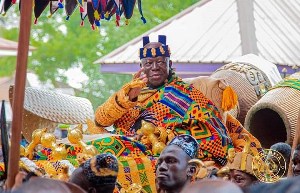- Home - News
- TWI News | TV
- Polls
- Year In Review
- News Archive
- Crime & Punishment
- Politics
- Regional
- Editorial
- Health
- Ghanaians Abroad
- Tabloid
- Africa
- Religion
- Election 2020
- Coronavirus
- News Videos | TV
- Photo Archives
- News Headlines
- Press Release
Opinions of Wednesday, 16 September 2015
Columnist: Trends and Rating Consult
Making High School Education more accessible in Ghana
The government is not only absorbing the fees of all day SHS students, it is also building new schools, yet even so close to the start of the free SHS programme details about its implementation and goal remains fuzzy.
Background
When the next academic year begins in September, 2015, some 367,565 students in some Senior High Schools (SHS) will not pay school fees for the entire period of schooling at their various institutions. They will be the first beneficiaries of the state’s Progressively Free SHS Programme (PFSP), which the government says is ultimately aimed at making SHS education free for all in years to come.
The programme brings a new property to the subject of how to manage the country’s education; which has been debated again and again over decades. Education has been a key subject in the last two general elections and is certain to come up yet again.
The then three-year Senior Secondary School (SSS) system was changed to a four-year Senior High Schools (SHS) by the John Kufuor/NPP government, convinced that the extra year will boost quality. Holding an opposing view, the Atta Mills/NDC government that followed reversed that change. Years on, there is in principle a bipartisan position to make SHS education more accessible by making it free. The most effective way to do so, is where the two dominant political groups differ.
Presently, parents whose children will be attending SHS in the coming academic year know that, they may be one of some 367,565 students to go to school without having to pay tuition fees; provided the school to be attended is a day school. For a long time it was unclear what will actually go into the choosing process, i.e. who among day students have a chance at free education. That answer soon came by way of a statement from the Ghana Education Service (GES) on 27 August, 2015, which read that, all day students were exempted from the payment of school fees .
Improving Access
The government is not only absorbing the fees of all day SHS students, it is also building new schools. This is very revealing of its intent to tackle two major factors hampering access to SHS education. Only a fraction of those who complete their basic education enrol in SHS. Though the reasons for that vary, they have always included the inability of some parents to pay fees and the limited intake capacities of schools. It is, as such, a sensible approach to resolve both concurrently.
Given the importance of these problems, chances are that lifting the responsibility to pay school fees from some parents could very well be the reason that their children get to enrol in SHS and stay till the completion of its 3-year programme. Indeed, this likelihood and others like it, have been the government’s strongest claim for free SHS.
It is also keen on boosting intake at the SHS level, and this it hopes to do by building 200 Community Day Senior High Schools. Two schools out of the 50 which constitute the first phase of the construction process have been completed. The average cost of each school is about GH¢7.8M. Some 23 others are to be constructed under the Wold Bank funded US$156 million Ghana Secondary Education Improvement Project (SEIP).
The expectation is that, students who pass their exam but wouldn’t have gained entry into high schools due to the limited intake capacities, will now have a chance with the expanded intake that the new schools bring, moreover, they will attend for free.
The Cost of Free Schooling
Crucial to the decision to start PFSP with day students only, must be the issue of cost; essentially, how much the state is willing to, or can reasonably allocate to foot the bill for free SHS schooling. The progressively free SHS programme will cost the state GH? 71 million, when it is rolled out for the first time , said the President early this year. However, in the 2015 budget statement it is also said that “an amount of GH?18.00 million has been provided to kick-start the programme in 2015”. The budget statement then went on to given an indication of what the funds will be used for, stating that, the “government will absorb GES-approved examination, library, entertainment, SRC, science development, sports, culture, and internet fees charged to secondary level students”.
Conceivably, the total cost of the programme would be much higher if the 367,565 beneficiaries would be boarding students, or at least included some of them, and not day students only. Fees released by GES for the coming academic year, direct that new SHS entrants (fresh students) into day schools shall pay GH? 405.50 while those into boarding ones will be charged GH¢724.50; GH? 319.00 (79%) more. In the year 2014/2015 continuing students paid GH? 73 and GH? 385 for day and boarding students, respectively.
Ghana Secondary Education Improvement Project (SEIP)
SEIP will run concurrently with the government’s own programme. Together the two programmes will reach close to 388,000 SHS students this year alone. SEIP will provide scholarships for 10,400 brilliant but needy students.
Like the progressively free SHS programme, it aims at increasing enrolment; by some 30,000. Part of the fund is also allocated for improving the learning outcomes for 150,000 additional students in low-performing schools.
Discrimination and Fairness
Without prejudice against the reasons that informed the government’s choice to start its progressively free SHS with a “free SHS for day students only” initiative, a real issue of fairness arises. It leads to thoughts of whether the government is rewarding the choice of day schooling and penalizing that to attend boarding schools. Surely, a more balanced option would have been the allocation of quotas for day and boarding students, perhaps with particular focus on the poor.
But the lack of such quotas and considerations for the vulnerable in society, and the use of students’ day-boarder status as the only criterion implies that, some 58% (506,465) of the total projected SHS student population for the 2015/2016 academic year (874030), will not qualify to be beneficiaries of the free SHS programme when it starts, owing to their boarding students’ status. The remaining 42% (all day students) are those exempt from paying fees.
While basic school pupils make their SHS choices ahead of their final exams, still not everyone is a boarder by choice. A good number are in boarding schools due to the computerised placement system which is programmed to exercise some discretion when placing students in schools. These individuals will by share chance – or the lack thereof –, not qualify for free SHS.
For a number of these unlucky students, relief may come by way of SEIP. Its structuring shows cognisance of a need to be fair, by targeting the poor in particular. However, the limited scholarship allocations it provides, means it’s very far from eliminating the much larger problem of unfairness to children and parents of boarding schools.
If any of these appears lost on the government, could it be because its attention is rather focused on a long term plan of shirking from managing boarding schools as a way of reducing its fiscal burden? Could the government be playing a political game to make SHS free in order weaken the fame of the opposition NPP who have made "Free SHS" their flagship agenda? Otherwise, there is the need to provide a good social and economic justification to the public, for rewarding day students a bursary of approximately GH?150 and leaving boarders without assistance.
Unintended Negative Outcomes
The apparent cost averse approach to the provision of free SHS education may have the unintended effect of further widening the gap in the delivery of quality education between students from well-off homes and those not. This thought arises, first with the understanding that eliminating cost alone, however well intended, does not improve quality; the present situation in the basic education system provides a good lesson.
Secondly, although the augment is that the entire high school education system needs improvement, boarding schools have always produced far greater numbers of comparatively good quality/well educated students than the day schools have managed to do. Just take a look at the annual high school rankings.
Now, what the “free SHS for day students only” initiative promises – however long it stays that way – is the ultimate incentive for poor parents to limit the choices of their children to day schooling with the hope of them attending school for free. Nudging parents to opt for day schools also means, brilliant but needy students in communities with poor schools are stuck to these poor schools – of which 200 more are to be built – when they could have been boarding students in top-performing schools.
Even as the goal is to ultimately make SHS education free for all, in the mean time when it is not, and when there is no indication or actual timetable of when it will be, this unfortunate turn of events remain a real possibility. So, while any kind of scholarship scheme is good, does the government have plans to manage unintended outcomes?
Limited and Obfuscating Information
Without doubt the government will commence the progressively free SHS programme when the new academic year opens in weeks, but even with so little time before it’s rolled out, the issue of how much will be spent remains a confused subject. The figure for how much the programme will cost when it starts have kept changing from President John Mahama’s GH?71 million claim, to GH?18.00 million contained in the 2015 budget, while estimates from the Ghana Education Service plus what the budget claims suggests GH?55.5 million per term; there are three terms per year.
Though none of these "official" figures came with details of how they were reached, the GH?18.00 million posited by the budget comes down to GH?50 for each of the estimated 360,000 plus students.
Just as confused, describes the issue of cost, lack, describes that of a timeline for the programme. There is no public knowledge of a clear timeline for completing of the program. What happens next year is unknown; also, what happens after the day students phase, is yet another unknown.
The point here is that, if the government is not hiding its real intentions about the programme, then it is doing very well at sending signals that, it is either confused or undertaking a program it is not willing or able to fully execute.
Conclusions
If Ghana’s education system is to be represented by a diagram, a pyramid will be a good fit. Its large base will march the vast numbers who are enrolled in basic school. The apex will typify the very few who finish their tertiary education. And somewhere in the middle will be the fraction from basic school who enter SHS and the fewer numbers who complete it. Estimates show that only 36% of those of SHS going age in Ghana are actually in school.
Faced with this picture and the added political pressure from an opponent promising a completely free SHS education, it is easy to be caught up in a state where some programme to at least easy entry into SHS is a must. Undoubtedly, the progressively free SHS policy is a good start to eventually expand access, but at what socio-economic expense?
This question is important at a time when the country’s finances is already troubled, and has led to a fall in the value of the national currency and the withdrawal of some state subsidies. So, if the state already has far less money than it needs, then from where is the funding coming? Which project(s) have given way for free SHS to be possible? Also, if there exists a plan beyond the discriminatory day-students-only phase of the project, then conceivably, more funding will be needed; from where will it be sourced?
Then again, although easing access to SHS is a commendable project, it cannot on its own be the ultimate aim. One would hope that it is tied to some long term national development goals. If so, these goals and how the progressively free SHS programme help achieve them must be known to the government. There is no reason to continue to withhold them from the public.
In just under four and a half years hence, the Wold Bank funded SEIP will run out. By then, some 30,000 SHS entrants would have been awarded scholarships and another 150,000 received some forms of aid. While the scholarship is good, what happens when funding runs out in 2020? What plans will kick in to sustain the project? How shall the state make sure that many who share the same rights to free education as those who are been aided now, are not left unattended to?
Entertainment










